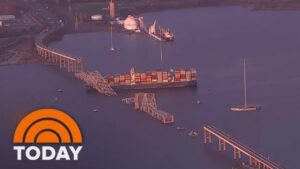A dramatic incident unfolded this morning at the port of Baltimore, as the entire Francis Scott Key Bridge in the harbor collapsed into the water following a collision with a cargo container ship.
The deafening sound of the impact left many wondering what had just occurred, with the ship striking the key bridge and causing it to sink entirely.
Prior to the collision, video footage captured smoke emanating from the ship, hinting at a potential issue before the disastrous crash.
The Key Bridge, a crucial route across the Patapsco River, met its demise in the early hours of the morning at 1:30 a.m. As cars crossed moments before the ship’s strike, the unfolding tragedy was captured on camera.
Despite the early hour, emergency response teams, including the fire department and Coast Guard, quickly mobilized to the scene.
Rescuers initiated a frantic search and rescue operation, detecting submerged vehicles in the water using sonar technology.
The vessel involved was identified as the nearly 950-foot container ship named Dolly, en route from Baltimore to Sri Lanka.
The Synergy Marine Corporation, responsible for the vessel, confirmed that all crew members, including the two pilots, were safe and accounted for.
The ship reportedly lost power during the incident, leading to the catastrophic collision with the bridge pillar.
As daylight broke, search teams continued scouring the waters for any potential survivors amidst the aftermath of the collapse.
With the cold weather posing a significant threat to anyone stranded in the water, concerns arose about the survivability of individuals in such conditions.
The frigid temperatures, both in the water and outside, raised alarm bells about the limited time frame for survival, emphasizing the urgency of the ongoing search efforts.
As investigations into the cause of the collision commenced, authorities highlighted the complexity of navigating the Baltimore Harbor and Chesapeake Bay waters, requiring local marine pilots for safe passage.
The National Transportation Safety Board (NTSB) took charge of the inquiry to unravel the sequence of events leading to the bridge collapse.
The impact of the bridge collapse reverberated throughout Baltimore and neighboring counties, prompting a unified response from state authorities and emergency services.
The disruption caused by the closure of the key transportation routes underscored the gravity of the situation, with implications for both local traffic and maritime operations.
Amidst the chaos and disbelief surrounding the incident, questions loomed about the ship’s control and the structural integrity of the bridge.
The vulnerability exposed by the collision and subsequent collapse raised concerns among residents, leaving many pondering the safety measures in place to prevent such disasters in the future.
As the sun rose over the scene, helicopters scoured the water for any signs of life, symbolizing the relentless search effort underway.
The aftermath of the bridge collapse served as a stark reminder of the unpredictability of such tragedies, urging communities to come together in a time of crisis.
The city of Baltimore grappled with the aftermath of the bridge collapse, with major transportation routes disrupted and the bustling port facing uncertainty.
The resilience of the community would be tested as authorities worked tirelessly to assess the damage and restore normalcy to the affected areas.
In conclusion, the bridge collapse at the port of Baltimore sent shockwaves through the region, underscoring the importance of safety measures in maritime navigation and infrastructure maintenance.
The collaborative response to the crisis highlighted the unity and resilience of the community in the face of adversity, as efforts continued to ensure the safety and well-being of all those impacted by the tragic event.
